Jupiter’s moon Io – new discoveries about the most volcanically active world in the Solar System
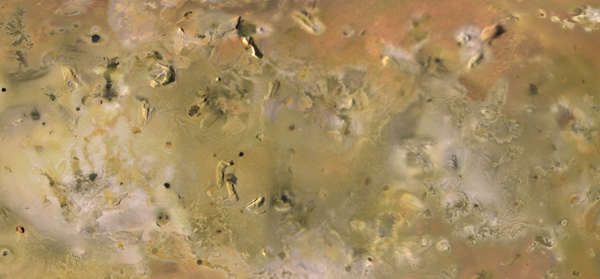
Jupiter’s moon Io is the most volcanically active world in the Solar System. It has hundreds of volcanoes and volcanic activity 25 times that of Earth. However, according to NASA and European Space Agency researchers, the concentrations of volcanic activity are significantly displaced from where they are expected to be based on models that predict how the moon’s interior is heated.
The team, which includes Rosaly Lopes of NASA’s Jet Propulsion Laboratory, Pasadena, Calif., primarily used data from NASA’s Voyager and Galileo missions. Their new paper also analyzes data from other spacecraft and ground-based telescopes, but much of what scientists know about Io’s surface comes from these two missions. Voyager, still being managed by JPL, discovered Io’s volcanoes in 1979, making that moon the only body in the solar system other than Earth known to have active magma volcanoes at the time. Galileo, which was also a JPL mission, flew by Io in 1999 and 2000.
Observations made by NASA’s New Horizon project in 2007 had the vantage point of capturing the giant plume from Io’s Tvashtar volcano. The debris were ejected to 330 km (250 miles) above the surface of the moon.
Masubi and Zal erupted alongside Tvashtar, ejecting three plumes high above. Loki, a virtual lake of lava and Boosaule Mons, which at 18 km (11 miles) is the highest mountain on Io and one of the highest mountains in the solar system can all be seen together in the five images captured by LORRI (Long Range Reconnaissance Imager) on the New Horizons spacecraft.
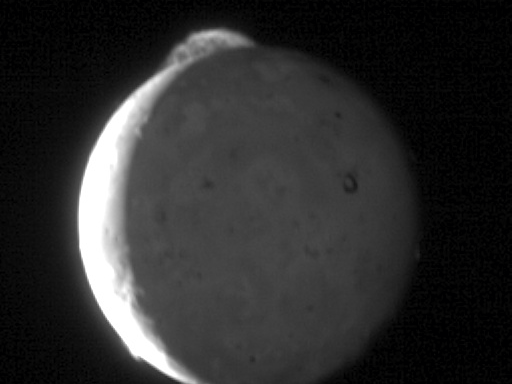 This five-frame sequence of New Horizons images captures the giant plume from Io’s Tvashtar volcano. Image Credit: NASA/Johns Hopkins University Applied Physics Laboratory/Southwest Research Institute
This five-frame sequence of New Horizons images captures the giant plume from Io’s Tvashtar volcano. Image Credit: NASA/Johns Hopkins University Applied Physics Laboratory/Southwest Research Institute The reason for the intense volcanism is the effect of the immense gravitational pull of Jupiter, Europa and Ganymede. Io has a oval orbit around Jupiter and can complete one whole revolution twice as fast as Europa and at four times the speed of Ganymede all due to the massive amount of gravity pull in all directions.
When Io is closer to Jupiter it feels a greater pull than when its away. This flexing gravity causes tidal heating which in turns causes friction, creating the perfect setup for volcanoes to blast away.
Io’s volcanoes not where they were expected to be
“The unexpected eastward offset of the volcano locations is a clue that something is missing in our understanding of Io,” study lead author Christopher Hamilton of the University of Maryland said in a statement. “In a way, that’s our most important result. Our understanding of tidal heat production and its relationship to surface volcanism is incomplete.”
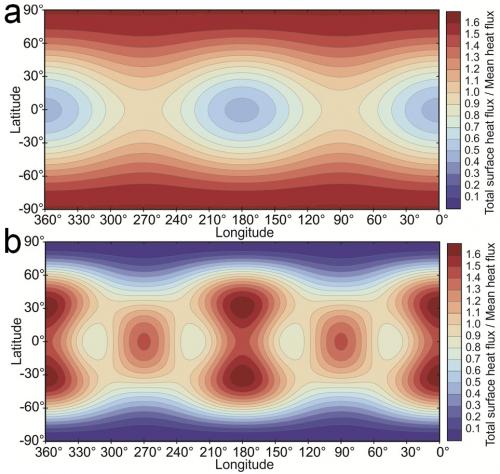 This is a map of the predicted heat flow at the surface of Io from different tidal heating models. Red areas are where more heat is expected at the surface while blue areas are where less heat is expected. Figure A shows the expected distribution of heat on Io’s surface if tidal heating occurred primarily within the deep mantle, and figure B is the surface heat flow pattern expected if heating occurs primarily within the asthenosphere. In the deep mantle scenario, surface heat flow concentrates primarily at the poles, whereas in the asthenospheric heating scenario, surface heat flow concentrates near the equator. Credit: NASA/Christopher Hamilton
This is a map of the predicted heat flow at the surface of Io from different tidal heating models. Red areas are where more heat is expected at the surface while blue areas are where less heat is expected. Figure A shows the expected distribution of heat on Io’s surface if tidal heating occurred primarily within the deep mantle, and figure B is the surface heat flow pattern expected if heating occurs primarily within the asthenosphere. In the deep mantle scenario, surface heat flow concentrates primarily at the poles, whereas in the asthenospheric heating scenario, surface heat flow concentrates near the equator. Credit: NASA/Christopher Hamilton The asthenosphere, a shallow under the crust of Io generates all the heat and slowly deforms under the immense heat and pressure.
“Our analysis supports the prevailing view that most of the heat is generated in the asthenosphere, but we found that volcanic activity is located 30 to 60 degrees East from where we expect it to be,” said Christopher Hamilton of the University of Maryland, College Park. Hamilton, who is stationed at NASA’s Goddard Space Flight Center in Greenbelt.
Hamilton and his team are working hard and fast to understand the whole story of Io. Using the latest geological map, they have studied the patterns and trying to completely fathom all the possibilities.
“We performed the first rigorous statistical analysis of the distribution of volcanoes in the new global geologic map of Io,” says Hamilton. “We found a systematic eastward offset between observed and predicted volcano locations that can’t be reconciled with any existing solid body tidal heating models.”
“Our analysis supports a global subsurface magma ocean scenario as one possible explanation for the offset between predicted and observed volcano locations on Io,” says Hamilton. “However, Io’s magma ocean would not be like the oceans on Earth. Instead of being a completely fluid layer, Io’s magma ocean would probably be more like a sponge with at least 20 percent silicate melt within a matrix of slowly deformable rock.”
The Voyagers, Galileo, Cassini and New Horizons have passed and observed the many active volcanoes on the face of this celestial body. These observations and that made by Earth-based astronomers have revealed more than 150 active volcanoes. The prediction is of 400 volcanoes to be present there.
Io’s volcanism has made it one of the currently known volcanically active worlds in the solar system, the other four being Earth, Venus, Saturn’s moon Enceladus, and Neptune’s moon Triton.
There are hundreds of volcanic centres and extensive lava formations on Io thanks to its hyper-active volcanism.
Io’s volcanic plumes are spectacular due to the ejection of volatile elements at a speed of 1 kilometer per second, creating umbrella shaped clouds of gas. While striking in appearance, volcanic plumes are uncommon and have only been observed at a couple of dozen of eruptions. Io’s volcanoes are very out of place, giving it a very mysterious air around it.
Global geologic map of Io
Last year, for the first time, scientists have created a global geologic map of Jupiter’s moon Io.
The map, which was published in March 2012 by the U.S. Geological Survey (USGS), shines a light on Io, the fourth-largest satellite in the solar system.
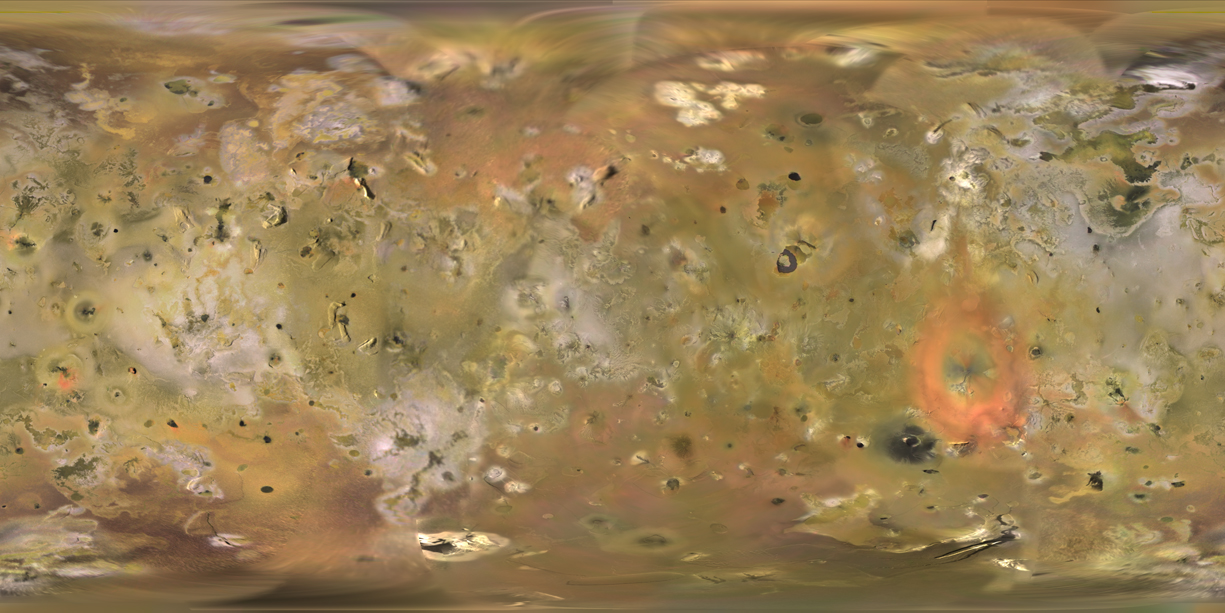 This first-ever complete map of Jupiter’s volcanic moon Io released on March 19, 2012, was created using data and images from NASA’s Galileo spacecraft, (which studied Jupiter and its moons between 1995 and 2003) and the Voyager mission in 1979. Color views from Galileo were superimposed on higher-resolution monochrome images.
This first-ever complete map of Jupiter’s volcanic moon Io released on March 19, 2012, was created using data and images from NASA’s Galileo spacecraft, (which studied Jupiter and its moons between 1995 and 2003) and the Voyager mission in 1979. Color views from Galileo were superimposed on higher-resolution monochrome images.CREDIT: USGS
“This new map of Io’s geology provides for the first time a detailed record of the different types of landforms and deposits that form the surface and presents a global context that is important for understanding Io’s internal evolution and volcanic processes, as well as for targeting future observations of Io,” David Crown, of the Planetary Science Institute in Tucson, Ariz., said in a statement.
About Io
The first reported observation of Io was made by Galileo Galilei on January 7, 1610 using a 20x-power, refracting telescope at the University of Padua. However, in that observation, Galileo could not separate Io and Europa due to the low power of his telescope, so the two were recorded as a single point of light. Io and Europa were seen for the first time as separate bodies during Galileo’s observations of the Jupiter system the following day, January 8, 1610 (used as the discovery date for Io by the IAU).
The first spacecraft to pass by Io were the twin Pioneer 10 and 11 probes on December 3, 1973 and December 2, 1974 respectively.
When the twin probes Voyager 1 and Voyager 2 passed by Io in 1979, their more advanced imaging system allowed for far more detailed images. Voyager 1 flew past the satellite on March 5, 1979 from a distance of 20,600 km (12,800 mi). The images returned during the approach revealed a strange, multi-colored landscape devoid of impact craters. The highest-resolution images showed a relatively young surface punctuated by oddly shaped pits, mountains taller than Mount Everest, and features resembling volcanic lava flows. Voyager 2 passed Io on July 9, 1979 at a distance of 1,130,000 km (702,000 mi). Though it did not approach nearly as close as Voyager 1, comparisons between images taken by the two spacecraft showed several surface changes that had occurred in the four months between the encounters.
The Galileo spacecraft arrived at Jupiter in 1995 after a six-year journey from Earth to follow up on the discoveries of the two Voyager probes and ground-based observations taken in the intervening years. Io’s location within one of Jupiter’s most intense radiation belts precluded a prolonged close flyby, but Galileo did pass close by shortly before entering orbit for its two-year, primary mission studying the Jovian system (The Jovian – i.e. pertaining to Jupiter). While no images were taken during the close flyby on December 7, 1995, the encounter did yield significant results, such as the discovery of a large iron core, similar to that found in the rocky planets of the inner Solar System
The Galileo mission was twice extended, in 1997 and 2000. During these extended missions, the probe flew by Io three times in late 1999 and early 2000 and three times in late 2001 and early 2002. Observations during these encounters revealed the geologic processes occurring at Io’s volcanoes and mountains, excluded the presence of a magnetic field, and demonstrated the extent of volcanic activity. In December 2000, the Cassini spacecraft had a distant and brief encounter with the Jupiter system en route to Saturn, allowing for joint observations with Galileo. These observations revealed a new plume at Tvashtar Paterae and provided insights into Io’s aurorae.
Io is the innermost of the four Galilean moons of the planet Jupiter and, with a diameter of 3,642 kilometres (2,263 mi), the fourth-largest moon in the Solar System. It was named after the mythological character of Io, a priestess of Hera who became one of the lovers of Zeus.
With over 400 active volcanoes, Io is also the most geologically active object in the Solar System.This extreme geologic activity is the result of tidal heating from friction generated within Io’s interior as it is pulled between Jupiter and the other Galilean satellites—Europa, Ganymede and Callisto. Several volcanoes produce plumes of sulfur and sulfur dioxide that climb as high as 500 km (300 mi) above the surface. Io’s surface is also dotted with more than 100 mountains that have been uplifted by extensive compression at the base of the moon’s silicate crust. Some of these peaks are taller than Earth’s Mount Everest.
Unlike most satellites in the outer Solar System, which are mostly composed of water ice, Io is primarily composed of silicate rock surrounding a molten iron or iron sulfide core. Most of Io’s surface is characterized by extensive plains coated with sulfur and sulfur dioxide frost.
Io’s volcanism is responsible for many of the satellite’s unique features. Its volcanic plumes and lava flows produce large surface changes and paint the surface in various shades of yellow, red, white, black, and green, largely due to allotropes and compounds of sulfur. Numerous extensive lava flows, several more than 500 km (300 mi) in length, also mark the surface. The materials produced by this volcanism provide material for Io’s thin, patchy atmosphere and Jupiter’s extensive magnetosphere. Io’s volcanic ejecta also produce a large plasma torus around Jupiter. (Wikipedia)
Io’s interaction with Jupiter’s magnetosphere
Although overall the shape of Jupiter’s magnetosphere resembles that of the Earth’s, closer to the planet its structure is very different. Jupiter’s volcanically active moon Io is a strong source of plasma in its own right, and loads Jupiter’s magnetosphere with as much as 1,000 kg of new material every second.
This material is mostly composed of ionized and atomic sulfur, oxygen and chlorine; atomic sodium and potassium; molecular sulfur dioxide and sulfur; and sodium chloride dust. These materials ultimately have their origin from Io’s volcanic activity, but the material that escapes to Jupiter’s magnetic field and into interplanetary space comes directly from Io’s atmosphere. These materials, depending on their ionized state and composition, ultimately end up in various neutral (non-ionized) clouds and radiation belts in Jupiter’s magnetosphere and, in some cases, are eventually ejected from the Jovian system.
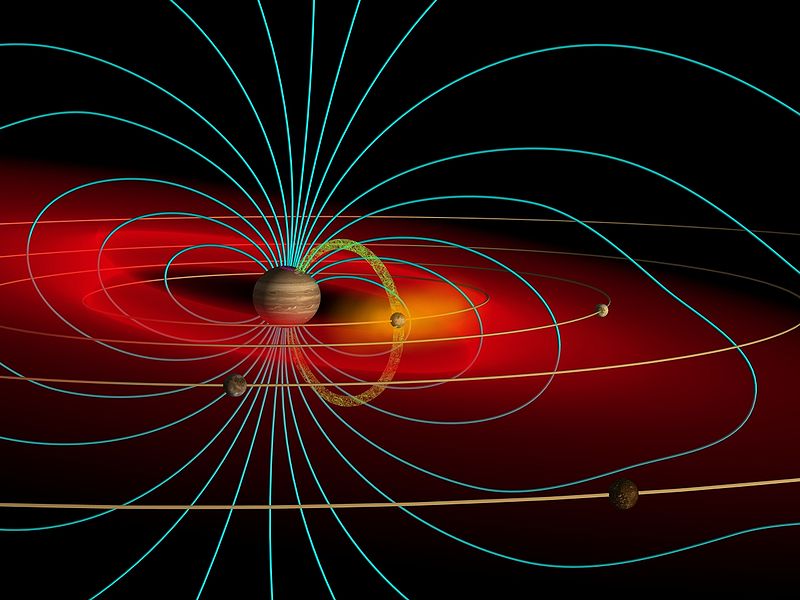 Schematic of the Jovian magnetosphere showing the Io Plasma Torus (in red), the Neutral Sodium immediately surrounding Io (in yellow), the Io flux tube (in green), and magnetic field lines (in blue).
Schematic of the Jovian magnetosphere showing the Io Plasma Torus (in red), the Neutral Sodium immediately surrounding Io (in yellow), the Io flux tube (in green), and magnetic field lines (in blue). Io orbits within a belt of intense radiation known as the Io plasma torus. The plasma in this doughnut-shaped ring of ionized sulfur, oxygen, sodium, and chlorine originates when neutral atoms in the “cloud” surrounding Io are ionized and carried along by the Jovian magnetosphere. Unlike the particles in the neutral cloud, these particles co-rotate with Jupiter’s magnetosphere, revolving around Jupiter at 74 km/s. Like the rest of Jupiter’s magnetic field, the plasma torus is tilted with respect to Jupiter’s equator (and Io’s orbital plane), meaning Io is at times below and at other times above the core of the plasma torus.
The torus is composed of three sections: an outer, “warm” torus that resides just outside Io’s orbit; a vertically extended region known as the “ribbon”, composed of the neutral source region and cooling plasma, located at around Io’s distance from Jupiter; and an inner, “cold” torus, composed of particles that are slowly spiraling in toward Jupiter. After residing an average of 40 days in the torus, particles in the “warm” torus escape and are partially responsible for Jupiter’s unusually large magnetosphere, their outward pressure inflating it from within.
Jupiter’s magnetic field lines, which Io crosses, couples Io’s atmosphere and neutral cloud to Jupiter’s polar upper atmosphere through the generation of an electric current known as the Io flux tube. This current produces an auroral glow in Jupiter’s polar regions known as the Io footprint, as well as aurorae in Io’s atmosphere. Particles from this auroral interaction act to darken the Jovian polar regions at visible wavelengths. The location of Io and its auroral footprint with respect to the Earth and Jupiter has a strong influence on Jovian radio emissions from our vantage point: when Io is visible, radio signals from Jupiter increase considerably.
The Juno mission, planned for the next decade, should help to shed light on these processes. The Jovian magnetic field lines that do get past Io’s ionosphere also induce an electric current, which in turn creates an induced magnetic field, within Io’s interior. Io’s induced magnetic field is thought to be generated within a partially molten, silicate magma ocean 50 kilometers beneath the moon’s surface. Similar induced fields were found at the other Galilean satellites by Galileo, generated within liquid water oceans in the interiors of those moons.
References:
jpl.nasa.gov
wikipedia.org/wiki/Io
phys.org
space.com
Featured image: NASA

Commenting rules and guidelines
We value the thoughts and opinions of our readers and welcome healthy discussions on our website. In order to maintain a respectful and positive community, we ask that all commenters follow these rules.